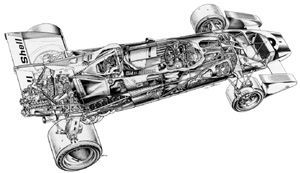Yeah, like I mentioned before, it was here at F1Technical I found the drawing...
Anyway, it seems little doubt remains about the construction of that chassis. I inquired specifically for a
honeycomb Al chassis and it seems clear that the 312B3 was made with aluminium sheets. Every photo or drawing I was able to find of F1 chassis that didn't use honeycomb needed some kind of frame reinforcement. As I've mentioned before, to the extent of my knowledge, only in the final years of the 70's appeared chassis where all the stresses and loads were supported only by the outer skin, or shell.
Surely, that chassis is a
monocoque in the same sense the Lotus 25 of 1962 was one. Photo of the first F1
monocoque:

The thing is that monocoque construction was pioneered in aviation and in aeronautical terms, most of the
monocoque chassis in F1 were really
semi-monocoques. From
Wikipedia:
Wikipedia wrote:World War II was a major catalyst for aircraft development. At the beginning of the war monocoque construction was in its infancy and many aircraft still used mixed construction or internal frames; by the end of the war, all high-performance planes were monocoque or semi-monocoque.
From the same source, an aeronautical example of semi-monocoque construction, a tail of a kit aircraft, the
Murphy Moose:

In this strict sense, I believe the right answer is indeed the 126C/2. Best picture I found on the net of its chassis is from a (fairly detailed) model:

This construction eliminated
all internal reinforcements, besides all the rivets. It was made from two shells (upper and lower), joined (bonded?) together.
Xpensive, I would love to hear your "poisonous" question, maybe if Timbo doesn't make a new one in a day or so, you can proceed.







